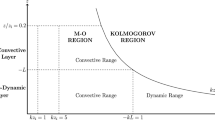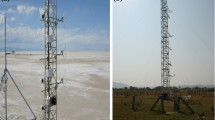Abstract
There are two models for the surface layer in the convective boundary layer (CBL). First is the standard Monin–Obukhov similarity theory, and second is the McNaughton–Laubach model (Laubach and McNaughton 2009, Boundary-Layer Meteorology 133:219–252; hereafter MNL model) developed based on the complex dynamical system approach to address characteristics of the unstable surface layer. The fundamental difference between the Monin–Obukhov similarity theory and the MNL model is the use of local and non-local parameters for analyzing surface-layer spectra in the CBL. However, there is a need to check applicability of this new model at various flow conditions before the model could be extensively used. Subsequently, applicability of the MNL model is tested in comparison to the standard model using CBL observations from three different regions with increasing terrain complexity (i.e. over flat-terrain, onslope, and ridge-top sites). The MNL model is tested by estimating and using the non-local scaling parameters to collapse the power spectra of velocity and temperature on the frequency–amplitude scale under the generalized hypothesis that convective surface layer depends on non-local outer variables. We find that the u and v spectra for all sites indicate run-to-run similarity of each spectra with MNL scaling irrespective of the height limiting role of local buoyancy on the shape of the spectra. Similarly, w spectra from all sites indicate transitions between the surface friction layer and the outer layer are governed by flow in the entire CBL. The temperature spectra collapse using \((z \epsilon _o)^{2/3} H_0^{-2}\) as amplitude scaling and \(kz_i^{1/2}z^{1/2}\) as wavenumber scaling, is a new observation within the surface friction layer, where the streamwise wavenumber is k, measurement height is z, CBL height is \(z_i\), the dissipation rate of turbulence energy in the outer CBL is \(\epsilon _o\), and the surface heat flux is \(H_0\). These observations corroborate well with the MNL model conjecture that the convective temperature spectra do not depend only on local stability, and CBL parameters affect spectra when a subset of local factors remains constant.







Similar content being viewed by others
References
Al-Jiboori M, Yumao X, Yongfu Q (2001) Turbulence characteristics over complex terrain in west China. Boundary-Layer Meteorol 101(1):109–126
Betchov R, Yaglom A (1971) Comments on the theory of similarity as applied to turbulence in an unstably stratified fluid. Izv Akad Nauk SSSR, Ser Fiz Atmosf i Okeana 7:1270–1279
Chowdhuri S, Prabhakaran T (2018) An evaluation of the dissimilarity in heat and momentum transport through quadrant analysis for an unstable atmospheric surface-layer flow. Environ Fluid Mech. https://doi.org/10.1007/s10652-018-9636-2
Chowdhuri S, McNaughton K, Prabhakaran T (2019) An empirical scaling analysis of heat and momentum cospectra above the surface friction layer in a convective boundary layer. Boundary-Layer Meteorol. https://doi.org/10.1007/s10546-018-0397-8
Deardroff J (1972) Numerical investigations of neutral and unstable planetary boundary layers. J Atmos Sci 29:91–115
Foken T, Nappo C (2008) Micrometeorology. Springer, Berlin
Garratt JR (1992) The atmospheric boundary layer. Cambridge University Press, Cambridge
Holtslag A, Nieuwstadt F (1986) Scaling the atmospheric boundary layer. Boundary-Layer Meteorol 36:201–209
Kader BA, Yaglom AM (1990) Mean fields and fluctuation moments in unstably stratified turbulent boundary layers. J Fluid Mech 212(1):637–662. https://doi.org/10.1017/S0022112090002129
Kaimal J, Finnigan J (1994) Atmospheric boundary layer flows: their structure and measurement. Oxford University Press, New York
Kaimal J, Wyngaard J, Izumi Y, Cote O (1972) Spectral characteristics of surface-layer. Q J R Meteorol Soc 98:563–589
Kaimal J, Wyngaard J, Haugen D, Cote O, Izumi Y, Coughey S, Readings C (1976) Turbulence structure in the convective boundary layer. J Atmos Sci 33:2152–2169
Katurji M, Sturman A, Zawar-Reza P (2011) An investigation into ridge-top turbulence characteristics during neutral and weakly stable conditions: velocity spectra and isotropy. Boundary-Layer Meteorol 139(1):143–160. https://doi.org/10.1007/s10546-010-9576-y
Laubach J, McNaughton K (2009) Scaling properties of temperature spectra and heat-flux cospectra in the surface friction layer beneath an unstable outer layer. Boundary-Layer Meteorol 133(2):219–252. https://doi.org/10.1007/s10546-009-9422-2
Lee X (1996) Turbulence spectra and eddy diffusivity over forests. J Appl Meteovol 35(8):1307–1318. https://doi.org/10.1175/1520-0450(1996)035\(<\)1307:TSAEDO\(>\)2.0.CO;2
Lorenz E (1963) Deterministic nonperiodic flow. J Atmos Sci 20:130–141
McNaughton K (2004a) Attached eddies and production spectra in the atmospheric logarithmic layer. Boundary-Layer Meteorol 111:1–18
McNaughton K (2004b) Turbulence structure of the unstable atmospheric surface-layer and transition to the outer layer. Boundary-Layer Meteorol 112(2):199–221
McNaughton K (2006) On the kinetic energy budget of the unstable atmospheric surface-layer. Boundary-Layer Meteorol 118:83–107
McNaughton K (2009) Rise and fall of Monin–Obukhov theory. AsiaFlux Newslett 30:1–4
McNaughton K, Clement R, Moncrieff J (2007) Scaling properties of velocity and temperature spectra above the surface friction layer in a convective atmospheric boundary layer. Nonlinear Process Geophys 14(3):257–271
McNaughton KG (2012) The flow of mechanical energy in convective boundary layers. Boundary-Layer Meteorol 145(1):145–163. https://doi.org/10.1007/s10546-011-9680-7
McNaughton KG, Chowdhuri S (2019) Temperature profiles, plumes and spectra in the surface-layers of convective atmospheric boundary layers. Nonlinear Proc Geophys. Discussion. https://doi.org/10.5194/npg-2019-43
Monin A, Obukhov A (1954) Osnovnye zakonomernosti turbulentnogo peremesivanija v prizemnom sloe atmosphery (Basic laws of turbulent mixing in the atmosphere near the ground). Trudy geofiz inst AN SSSR 24:163–187
Mukherjee S, Joshi R, Kumar K (2018) Compendium of meteorological data 2012–2016: field station: Kosi-Katarmal. Almora, Uttarakhand, Indian Himalayan Region. ISBN 978-93-5346-136-2, GB Pant National Institute of Himalayan Environment and Sustainable Development, Almora, India
Mukherjee S, Sturman A, McMillan A, Harvey M, Zawar-Reza P (2014) Assessment of error propagation in measured flux values of an eddy diffusivity based micrometeorological setup. Atmos Environ 84:144–155. https://doi.org/10.1016/j.atmosenv.2013.10.034
Paltridge G (1975) Global dynamics and climate—a system of minimum entropy exchange. Q J R Meteorol Soc 101:475–484
Panofsky H, Larko D, Lipschutz R, Stone G, Bradley E, Bowen A, Hojstrup J (1982) Spectra of velocity components over complex terrain. Q J R Meteorol Soc 108:215–230
Reynolds O (1895) On the dynamical theory of incompressible viscous fluids and the determination of the criterion. Phil Trans R Soc A 186:123–164
Richardson L (1920) The supply of energy from and to atmospheric eddies. Proc R Soc Lond 97:354–373
Smedman A, Hogstrom U, Hunt J, Sahlee E (2007) Heat/mass transfer in the slightly unstable atmospheric surface-layer. Q J R Meteorol Soc 133:37–51
Stull R (1988) An introduction to boundary-layer meteorology. Kluwer Academic Publishers, Dordrecht
Tennekes H (1970) Free convection in the turbulent Ekman layer of the atmosphere. J Atmos Sci 27(7):1027–1034
Townsend A (1956) The structure of turbulent shear flow. Cambridge University Press, Cambridge
Vickers D, Mahrt L (1997) Quality control and flux sampling problems for tower and aircraft data. J Atmos Ocean Technol 14(3):512–526. https://doi.org/10.1175/1520-0426(1997)014<0512:QCAFSP>2.0.CO;2
Webb EK (1988) Flow and transport in the natural environment: advances and applications. Springer, Berlin, pp 261–269
Welch P (1967) The use of fast Fourier transform for the estimation of power spectra: a method based on time averaging over short, modified periodograms. IEEE Trans Audio Electroac 15(2):70–73
Wilczak J, Oncley S, Stage S (2001) Sonic anemometer tilt correction algorithms. Boundary-Layer Meteorol 99:127–150
Wyngaard J (1992) Atmospheric turbulence. Ann Rev Fluid Mech 24:205–233
Yaglom A (1977) Comments on wind and temperature flux-profile relationships. Boundary-Layer Meteorol 11(1):89–102. https://doi.org/10.1007/BF00221826
Zhang Y, Liu H, Foken T, Williams QL, Liu S, Mauder M, Liebethal C (2010) Turbulence spectra and cospectra under the influence of large eddies in the energy balance experiment (EBEX). Boundary-Layer Meteorol 136(2):235–251. https://doi.org/10.1007/s10546-010-9504-1
Acknowledgements
S. Mukherjee, K. Kumar and P. Lohani are grateful to Ministry of Earth Sciences (MoES), Government of India, for providing a research Grant (MOES/16/25/2014-RDEAS) for this study. Director of GBPNIHESD, Almora, India is acknowledged for providing access to the instrumental and computational facilities. Authors S. Chowdhuri and T. Prabhakaran acknowledge support from MoES, Government of India, to conduct the CAIPEEX experiment. Thanks to Mr. Ashutosh Tiwari, GBPNIHESD, Almora, for providing the digital elevation data. Drs J. Laubach and K. McNaughton are acknowledged for contributing to technical improvements in this manuscript.
Author information
Authors and Affiliations
Corresponding author
Additional information
Publisher's Note
Springer Nature remains neutral with regard to jurisdictional claims in published maps and institutional affiliations.
Electronic supplementary material
Below is the link to the electronic supplementary material.
Rights and permissions
About this article
Cite this article
Mukherjee, S., Lohani, P., Kumar, K. et al. Assessment of New Alternative Scaling Properties of the Convective Boundary Layer: Application to Velocity and Temperature Spectra . Boundary-Layer Meteorol 176, 271–289 (2020). https://doi.org/10.1007/s10546-020-00525-w
Received:
Accepted:
Published:
Issue Date:
DOI: https://doi.org/10.1007/s10546-020-00525-w




